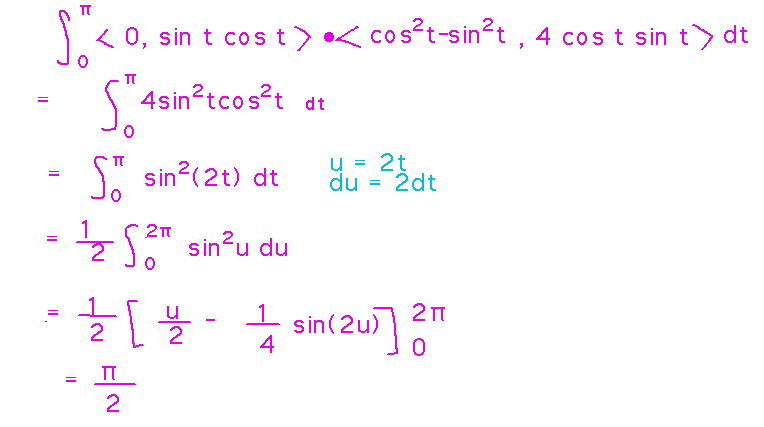Misc
Review Session
Study day (Wednesday May 2), 11:30 - 12:30, in our regular classroom.
Final Exam
Tuesday, May 8, 12:00 noon to 3:20 PM, in our regular classroom.
Comprehensive, but with an emphasis on material since the 2nd hour exam (e.g., directional derivatives, gradients, Lagrange multipliers, multiple integrals & their applications, line integrals, vector fields, etc.)
Designed to be 2 to 2 1/2 times as long as the hour exams, but you have 4 times as much time.
Rules and format otherwise similar to hour exams, particularly including the open-references rule.
I’ll provide a sample from a past semester.
I’ll bring donuts and cider.
SOFIs
6 filled out as of this morning - thank you!
They are useful to me in improving courses for the future, and you get 1 printer dollar / SOFI. So please fill them out.
Questions?
Green’s Theorem and Area
Find the area inside the curve r(t) = 〈 sin t cos t, 2 sin2t 〉, 0 ≤ t ≤ π.
A possibly helpful fact:
![]()
The key idea is that the double integral arising from Green’s theorem is an area if the integrand is 1. So Green’s theorem gives you a way to calculate area by evaluating a line integral around its boundary.

Since these area problems don’t involve any specific vector field, you can pick any one you like that makes the integrand 1. For example...

(The first of these is the one usually described in textbooks.)
Choosing to use the second vector field (F(x,y) = 〈 0, x 〉), the area turns out to be...

Key Point
Using Green’s theorem to calculate areas.
Source Free Fields
Source free fields are to flux integrals (integrals of F(r(t))•n(t)) as conservative fields are to circulation integrals (integrals of F(r(t))•r’(t)).
For example, for vector field F(x,y) =〈 P(x,y), Q(x,y) 〉
- Flux is path independent in a source free field
- Flux around any closed curve is 0 in a source free field
- Px + Qy = 0 in a source free field
Source free fields have “stream functions” analogous to potential functions: Given source free field G(x,y) = 〈 P(x,y), Q(x,y) 〉, a function g(x,y) is a stream function for G if P = gy and Q = -gx.
Next
An example of a source free vector field (see the book’s discussion starting at the bottom of page 720).
Divergence and curl.
Read section 6.5.